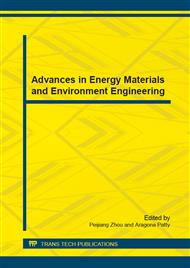p.225
p.230
p.235
p.239
p.245
p.249
p.253
p.257
p.261
Study on Separation/Enrichment of Trace Zinc Using Ternary Association Complex System
Abstract:
The paper presents a novel method for the separation/enrichment of trace Zn2+ using NH4SCN –dodecyl dimethyl benzyl ammonium bromide (DDBAB)-water system.The effects of different parameters on the enrichment yield of Zn2+ have been investigated. The possible enrichment mechanism of Zn2+ was discussed.The results show that under the optimum conditions, Zn (SCN)42- produced by Zn2+ and SCN- reacts with DDBAB cation (DDBAB +) to form the water-insoluble ternary association complex of [Zn (SCN)4](DDBAB)2, so Zn2+ was enriched quantitatively.While Al3+,Mn2+,Ni2+ and Pb2+ could not be enriched. Thereby, the quantitative separation of Zn2+ from the above metal ions could be achieved.A new method for the separation/enrichment of trace zinc was established. The proposed method has been successfully applied to the separation/enrichment of trace Zn2+ in the samles of synthetic water, and the enrichment yield is 96.4%-99.5%.
Info:
Periodical:
Pages:
245-248
Citation:
Online since:
December 2014
Authors:
Price:
Сopyright:
© 2015 Trans Tech Publications Ltd. All Rights Reserved
Share:
Citation:


